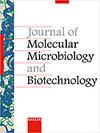Proteomic Analyses Uncover the Mechanisms Underlying Antibiotic Resistance Differences among Three Acinetobacter baumannii Isolates
IF 1.2
Q2 Biochemistry, Genetics and Molecular Biology
引用次数: 4
Abstract
This study aimed to investigate the molecular mechanisms underlying the antibiotic resistance difference among three Acinetobacter baumannii isolates. Fifty A. baumannii isolates were first subjected to an antimicrobial susceptibility test, then three isolates differing in antibiotic resistance were selected and subjected to iTRAQ (isobaric tags for relative and absolute quantification)-based proteomics analysis. Differential proteins among the three A. baumannii isolates were further identified and subjected to gene ontology functional enrichment analysis. A resistant isolate (A1), a less resistant one (A8) and a susceptible one (A9) were selected. In total, there were 424 differentially expressed proteins (DEPs) between the A1 and A8 isolates, 1,992 DEPs between the A9 and A1 isolates, and 1,956 DEPs between the A8 and A9 isolates. The upregulation of I6TUC8 and Q0GA83 in the A1 and A8 isolates may be responsible for their higher resistance to ceftriaxone. The higher gentamicin resistance of A. baumannii isolates A1 and A8 when compared to A9 may be related to the higher expression levels of O05286 and D0CCK1, while the higher Q2FCY1 expression level may contribute more to strong gentamicin resistance in A1. The higher levels of L9LWL7, L9MDB0, K9C9W3, E2IGU7, B6E129, G8HYR7, D2XTB0 and D2XTB0 may be responsible for the higher carbapenem resistance of isolate A1 as compared to A8.蛋白质组学分析揭示了三种鲍曼不动杆菌分离株抗生素耐药性差异的机制
本研究旨在探讨三株鲍曼不动杆菌耐药差异的分子机制。首先对50株鲍曼不动杆菌进行药敏试验,然后选择3株抗生素耐药性不同的分离株进行基于iTRAQ(相对和绝对定量等压标记)的蛋白质组学分析。进一步鉴定3株鲍曼不动杆菌的差异蛋白,并进行基因本体功能富集分析。筛选出耐药株A1、抗性较弱株A8和敏感株A9。结果表明,A1与A8分离株间存在424个差异表达蛋白,A9与A1分离株间存在1,992个差异表达蛋白,A8与A9分离株间存在1,956个差异表达蛋白。I6TUC8和Q0GA83在A1和A8分离株中的表达上调可能是它们对头孢曲松具有较高耐药性的原因。鲍曼不动杆菌A1和A8对庆大霉素的耐药性高于A9可能与O05286和D0CCK1表达水平较高有关,而较高的Q2FCY1表达水平可能更有助于A1对庆大霉素的强耐药性。菌株A1对碳青霉烯烯的抗性较A8高,可能是由于菌株L9LWL7、L9MDB0、K9C9W3、E2IGU7、B6E129、G8HYR7、D2XTB0和D2XTB0的表达水平较高。
本文章由计算机程序翻译,如有差异,请以英文原文为准。
求助全文
约1分钟内获得全文
求助全文
来源期刊

Journal of Molecular Microbiology and Biotechnology
生物-生物工程与应用微生物
CiteScore
3.90
自引率
0.00%
发文量
0
审稿时长
>12 weeks
期刊介绍:
We are entering a new and exciting era of microbiological study and application. Recent advances in the now established disciplines of genomics, proteomics and bioinformatics, together with extensive cooperation between academic and industrial concerns have brought about an integration of basic and applied microbiology as never before.
 求助内容:
求助内容: 应助结果提醒方式:
应助结果提醒方式:


